[1]
W. J. Choyke and G. Pensl, "Physical Properties of SiC," MRS Bull., vol. 22, no. 3, p.25–29, Mar. 1997.
DOI: 10.1557/S0883769400032723
Google Scholar
[2]
R. R. Siergiej et al., "Advances in SiC materials and devices: an industrial point of view," Mater. Sci. Eng. B, vol. 61–62, p.9–17, Jul. 1999.
DOI: 10.1016/S0921-5107(98)00438-3
Google Scholar
[3]
M. Alexandru et al., "SiC Integrated Circuit Control Electronics for High-Temperature Operation," IEEE Trans. Ind. Electron., vol. 62, no. 5, p.3182–3191, May 2015.
DOI: 10.1109/TIE.2014.2379212
Google Scholar
[4]
G. Pensl et al., "Traps at the SiC/SiO2-Interface," MRS Online Proc. Libr. OPL, vol. 640, p. H3.2, Jan. 2000.
DOI: 10.1557/PROC-640-H3.2
Google Scholar
[5]
V. V. Afanas'ev, "Electronic properties of SiO2SiC interfaces," Microelectron. Eng., vol. 48, no. 1, p.241–248, Sep. 1999.
DOI: 10.1016/S0167-9317(99)00379-2
Google Scholar
[6]
E. Pippel, J. Woltersdorf, H. Ö. Ólafsson, and E. Ö. Sveinbjörnsson, "Interfaces between 4H-SiC and SiO2: Microstructure, nanochemistry, and near-interface traps," J. Appl. Phys., vol. 97, no. 3, p.034302, Dec. 2004.
DOI: 10.1063/1.1836004
Google Scholar
[7]
D. J. Lichtenwalner et al., "Accelerated Testing of SiC Power Devices," in 2020 IEEE International Integrated Reliability Workshop (IIRW), Oct. 2020, p.1–6.
DOI: 10.1109/IIRW49815.2020.9312873
Google Scholar
[8]
A. Christou, Reliability of High Temperature Electronics. RIAC, 1996.
Google Scholar
[9]
E. K. Ashik et al., "Bias Temperature Instability on SiC n- and p-MOSFETs for High Temperature CMOS Applications," in 2022 IEEE International Reliability Physics Symposium (IRPS), Mar. 2022, p. 3B.4-1-3B.4-8.
DOI: 10.1109/IRPS48227.2022.9764565
Google Scholar
[10]
A. J. Lelis, R. Green, D. B. Habersat, and M. El, "Basic Mechanisms of Threshold-Voltage Instability and Implications for Reliability Testing of SiC MOSFETs," IEEE Trans. Electron Devices, vol. 62, no. 2, p.316–323, Feb. 2015.
DOI: 10.1109/TED.2014.2356172
Google Scholar
[11]
R. Green, A. Lelis, and D. Habersat, "Threshold-voltage bias-temperature instability in commercially-available SiC MOSFETs," Jpn. J. Appl. Phys., vol. 55, no. 4S, p. 04EA03, Mar. 2016.
DOI: 10.7567/JJAP.55.04EA03
Google Scholar
[12]
R. W. Kee, K. M. Geib, C. W. Wilmsen, and D. K. Ferry, "Interface characteristics of thermal Si02 on SiC," J. Vac. Sci. Technol., vol. 15, no. 4, p.1520–1523, Jul. 1978.
DOI: 10.1116/1.569779
Google Scholar
[13]
T. E. Rudenko, I. N. Osiyuk, I. P. Tyagulski, H. Ö. Ólafsson, and E. Ö. Sveinbjörnsson, "Interface trap properties of thermally oxidized n-type 4H–SiC and 6H–SiC," Solid-State Electron., vol. 49, no. 4, p.545–553, Apr. 2005.
DOI: 10.1016/j.sse.2004.12.006
Google Scholar
[14]
S. B. Isukapati et al., "Monolithic Integration of Lateral HV Power MOSFET with LV CMOS for SiC Power IC Technology," in 2021 33rd International Symposium on Power Semiconductor Devices and ICs (ISPSD), May 2021, p.267–270.
DOI: 10.23919/ISPSD50666.2021.9452235
Google Scholar
[15]
L. Dobrescu, M. Petrov, D. Dobrescu, and C. Ravariu, "Threshold voltage extraction methods for MOS transistors," in 2000 International Semiconductor Conference. 23rd Edition. CAS 2000 Proceedings (Cat. No.00TH8486), Oct. 2000, p.371–374 vol.1.
DOI: 10.1109/SMICND.2000.890257
Google Scholar
[16]
Y. Tsividis, Operation and Modeling of the Mos Transistor (The Oxford Series in Electrical and Computer Engineering). USA: Oxford University Press, Inc., 2004.
Google Scholar
[17]
V. Uhnevionak et al., "Comprehensive Study of the Electron Scattering Mechanisms in 4H-SiC MOSFETs," IEEE Trans. Electron Devices, vol. 62, no. 8, p.2562–2570, Aug. 2015.
DOI: 10.1109/TED.2015.2447216
Google Scholar


